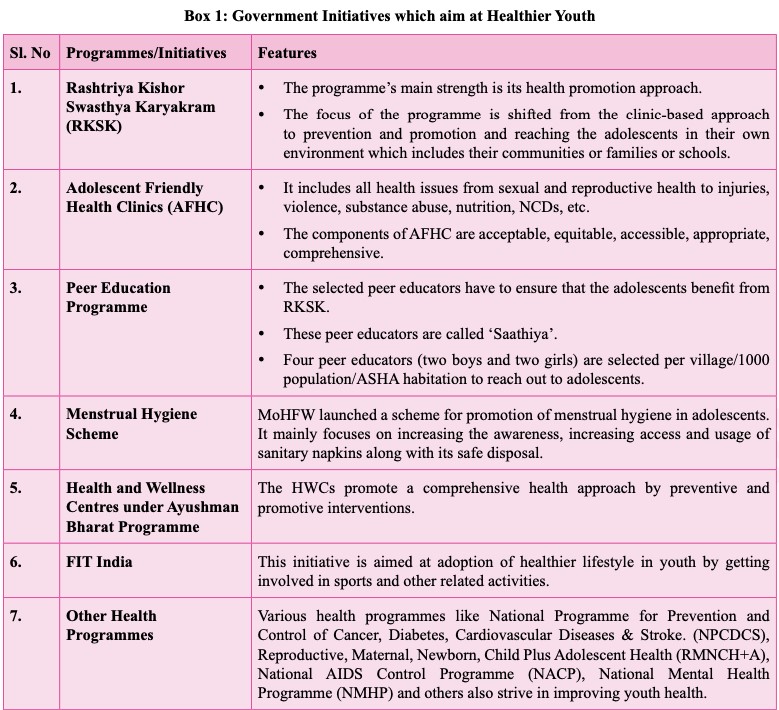Yojana Summary: February 2023 (Youth and Sports)
Introduction
India, with one of the largest youth populations in the world (27.2 % of the total population), seeks to reap its demographic dividend with suitable policy measures to usher a positive change in transforming India.
To tap the youth’s constructive and creative energies, the government has adopted a twin objective of personality building and nation-building.
Nurturing Excellence:
- India’s demographic dividend comprises a working-age population between 15-64 years, which is 67% of the total population.
- India seeks to benefit from this ‘golden period’ of 2020–2050.
- India is the 3rd largest ecosystem of startups, with 1 in every 10 globally belonging to
 Source: https://indoeuropean.eu/startup-20-indias-startup-report-card-worlds-3rd-largest-startup-ecosystem/
Source: https://indoeuropean.eu/startup-20-indias-startup-report-card-worlds-3rd-largest-startup-ecosystem/ - For skill development and employability of youth, the government has launched various schemes such as Skill India Mission, MUDRA scheme, Digital India, and PM Kaushal Vikas Yojana to provide market-centric skills to the upcoming workforce.
- New Education Policy:
- The policy’s implementation seeks to make India’s youth solution-oriented, agile and mentally equipped to handle real-life situations and operate in challenging environments.
- The new policy has prioritised efforts to boost literacy and numeracy achievements in primary schools while lowering dropout rates in middle and secondary schools.
- Adopting a multi-disciplinary approach, academic bank of credits, and multiple entry-exit options make higher education more responsive and flexible.
FIT INDIA:
- FIT INDIA was launched to make fitness an unabated part of our daily lives and has brought a paradigm shift in our approach towards sports.
- Initiatives were undertaken to strengthen the impact and spread awareness of FIT India:
- Samagra Shiksha Scheme,
- FIT India School Movement,
- FIT India School Week,
- FIT India Quiz,
- FIT India Freedom Run,
- Football for Schools Programme.
26th National Youth Festival Held at HUBBALI, KARNATAKA · The prime minister of India inaugurated the 26th National Youth Festival Held at HUBBALI, KARNATAKA, on January 12 on the birth anniversary of swami vivekananda. · The chief minister of Karnataka released the logo and mascot champi chikka of the National Youth Festival.
· ‘Viksit Yuva Viksit Bharat.’ is the theme of the festival this year.
Youth and Health:
- Mental health: This is a significant challenge due to the non-availability of mental health services and not recognising mental health as an issue to seek health care. The reasons for poor mental health include Poor school/workplace performance, poverty and unemployment, stigma, marginalisation and discrimination etc.
- Alcohol and drug abuse: can cause communicable and non-communicable diseases like HIV/AIDS, hypertension, cardiovascular diseases and liver diseases, etc. Also, mental health is compromised for youth associated with alcohol and drug abuse.
- Tobacco use: Tobacco can cause cancer of the oral cavity, throat, oesophagus, lungs, and many other health issues. Most individuals who use tobacco in any form begin doing so in their adolescence. Hence it is imminent to guide the youth in the early stages.
- Physical inactivity: Less physical activity causes an increase in risk factors and diseases, including obesity, hypertension, diabetes mellitus, heart diseases and other chronic diseases.
- Diabetes and hypertension are becoming epidemic, as 1 in every 10 adults has diabetes.
- Other health problems: These include injuries in the form of accidents, self-harm and workplace accidents.
To Better The Health of Youth Government Has Started the Following Initiatives:

Swachha Bharat Mission, provision of cooking gas through Ujjwala Yojana, electricity through Deen Dayal Upadhyaya Gram Jyoti Yojana, Saubhagya Yojana, bringing considerable changes in the lives of youths. The government has also initiated PM Awas Yojana, Jal Jeevan Mission, to provide basic necessities to the rural youth.
Youth and Environmental Sustainability:
In an attempt to attend zero emission targets by 2030 and ensure a better life for future generations, Youth-driven climate initiatives can be very handy.
Roles for Youth and the SDGs
- Critical thinkers- Youth can see and confront current power systems, obstacles to change, and inconsistencies and biases.
- Change-makers- Youth can mobilise others and take action. Globally, youth activism is increasing due to improved connectivity and access to social media.
- Innovators- Young people frequently have firsthand knowledge of and insights into unavailable topics to adults and bring new viewpoints. In addition, youth can provide fresh perspectives and unique solutions since they are most familiar with the issues they confront.
- Communicators- Young people can collaborate to spread the development agenda among their peers and communities locally and internationally.
-
- Inclusion of technology in governance can increase the participation of citizens in policy formation, implementation and administration overall.
- To attend this participatory governance, the government has launched MyGov Portal to increase citizens’ engagement with the government.
- MyGov seeks to increase participatory governance or ‘Jan Bhagidari’ by the following means:
- Information dissemination,
- Two-way communication,
- Transparency,
- Fact-checking,
- Infusing collaborations.
Leaders- Young people may influence change in their communities and nations when they are empowered with awareness of their rights and leadership abilities.
Role of Youth in Shaping Digital Economy:
1. The Gig Economy:
- Gig workers are self-reliant contractors, on-call, online platforms, contract firms, and temporary workers.
- The Gig economy in India is multiplying. As per the NITI Aayog report, about 7.7 million people were working in the gig economy in 2021-22.
- Gig jobs are finding increasing acceptance among the youth as they are more open to exploring opportunities of different kinds.
2. Growth of STEM:
The government is continuing its efforts in STEM (Science, Technology, Engineering, Mathematics) to build a large base of skilled technology workforce which can be employed internally and externally, thereby strengthening our economy.
Leading India towards Techade:
Government Initiatives:
The government of India is working towards providing opportunities to the youth and ease of living.
- Youth Volunteers: By Ministry of Youth Affairs and Sports to make the youth catalysts for change. These trained youth volunteers will play a pivotal role in realising the Panch Pran (five resolves) about which the Hon’ble Prime Minister spoke during his Independence Day Speech.
- FIT INDIA: Enabling the youth to actively participate in the FIT India movement to lead a fit and healthy lifestyle on the lines of the inspirational slogan ‘Fitness Ka Dose, Aadha Ghanta Roz‘.
- Khelo India Scheme: To make quality sports infrastructure equitably accessible to the citizens. Sports competitions and programmes are organised across the country, engaging the youth.
- Ease of Living: Provision of cooking gas through the Ujjwala Yojana, electricity through the Deen Dayal Upadhyaya Gram Jyoti Yojana and Saubhagya Yojana, bringing considerable changes in the lives of youths. The government has also initiated PM Awas Yojana, Jal Jeevan Mission, to provide basic necessities to the rural youth.
- Swachha Bharat Mission: Making the youth ambassadors and advocates of cleanliness across the country. Various activities were undertaken by the Ministry of Youth Affairs and Sports under Swachh Bharat 2.0, with youth as a focal point.
Conclusion:
Youth, as ambassadors of social entrepreneurship, can offer focused technical assistance in various fields of education, Health, skill training, and finance, among others.
The ambitious targets of the Indian government of attending a $5 trillion economy by 2025 and the goal to become the third largest economy in the world by 2030 heavily rely on the shoulders of Indian youth.




